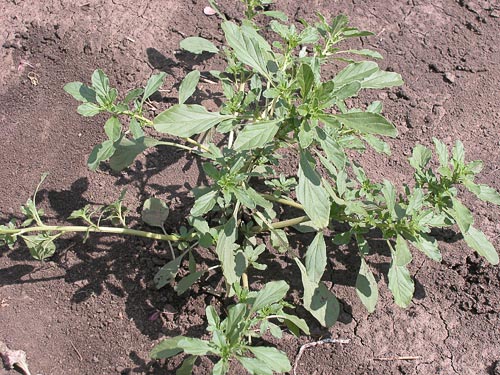Weeds
Amaranthus albus L. - Tumbleweed amaranth.
Taxonomic position.
Family Amaranthaceae Juss., genus Amaranthus L.Synonym.
Tumble pigweed.Biological group.
Annual seed-propagated aestival-autumnal weed, segetal-ruderal.Morphology and biology.
Stem is ramified from the base, erect to prostrate; branches are albescent, hairless, less often with sparse short scaly hairs, height 20-30 (70) cm. Foliage leaves are small, oblong obovate or spatulate, round or slightly emarginate at the top, with a point of 0.5-1 mm length, margin finely ruffled, toward the base tapered into the short petiole. Taproot penetrates to depth of 135-200 cm. Flowers are trimerous, in clusters or small spike-shaped inflorescences, located in the leaf axils. Hypocotyls are linear-lanceolate, awl-shaped pointed, paleaceous at the margins underneath, 1.5-2 times bigger than flowers. Fruit is an obovate boll; seeds are black, smooth, glossy, sharp at the edges, diameter 0.75-1 mm, thickness 0.5-0.6 mm. The mass of 1000 seeds is 0.3 g. The flowering period is July-September and the fruiting period is September-October. The resting period is 6-8 months. The maximum number of seeds that one plant produces is about 6 million seeds. The maximum depth at which shoots emerge from is 6-8 cm. Seeds in soil keep their ability to germinate for 40 years.Distribution.
Nearly cosmopolitan. Found in the south of Europe and the European part of the former USSR. Located specifically to the north from latitude 60 degrees North, the Caucasus, Western and Eastern Transcaucasia, the Western and Eastern parts of Siberia, the Far East, Kazakhstan, Central Asia, North Africa, North America.Ecology.
Xerophyte. Grows on dry, nutrient-rich, lighter soil. Prefers very warm locations. It is notable for extreme speed of distribution. Shoots emerge at the minimum temperature 10-12°C and optimum 28-36°C (from April-August).Economic value.
Infests tilled crops and grain crops, sugar beet, maize, soya and cotton crops; occurs in kitchen gardens, vineyards, orchards, along roads, railway tracks, near inhabited areas. It is suitable for sluing. Control measures: stubbling, inter-row cultivation, chemical weeding.Reference citations:
Maltsev A.I. 1962. Weed vegetation of the USSR and it control. Leningrad-Moscow: Publishing Office on Agricultural Literature, Journals and Posters. 172 p. (in Russian).Nikitin V.V. 1983. Weed plants in the flora of the USSR. Leningrad: Nauka. 170 p. (in Russian).
Shishkin B.K. 1936. Flora of the USSR. Moscow-Leningrad: Ac. Sc. USSR. V. 6: 364 (in Russian).
Uljanova T.N. 1988. Weed plants in the flora of Russia and other FSU states. St. Petersburg: VIR. 217 p. (in Russian).


